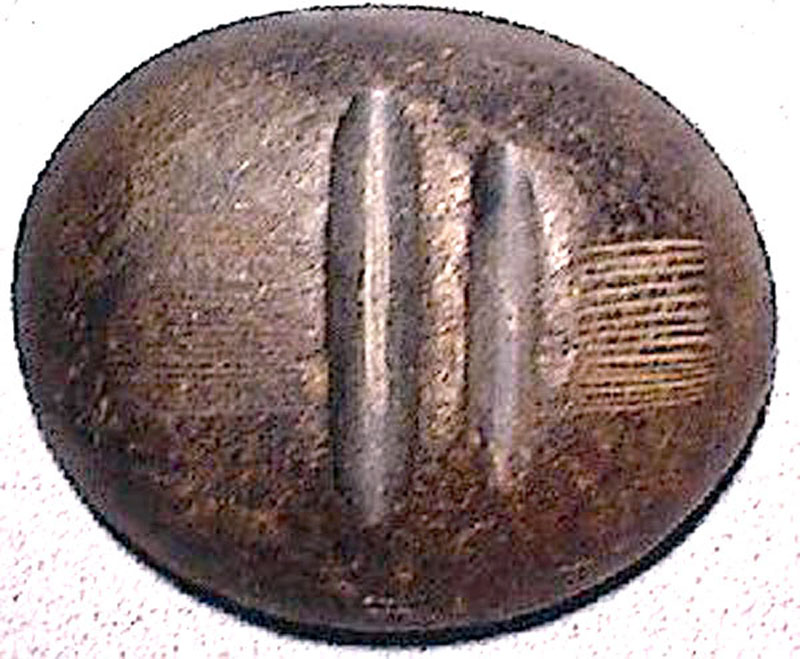|
|

Archaeology & Inventory of Bowers Cave.
Elsasser & Heizer 1963.
University of California Archaeological Survey No. 29 | April 15, 1963
The Archaology of Bowers Cave, Los Angeles County, California
Albert B. Elsasser and Robert F. Heizer.
|
Webmaster's Notes.
Elsasser and Heizer provide a good inventory of the Bowers Cave artifacts, but some of their interpretations warrant comment. They attribute the cave and its contents to the Chumash culture — i.e., Ventureño speakers of the coast — perhaps because Bowers' own focus was on the Chumash of Santa Barbara and Ventura counties. However, this cave, located in Los Angeles County, is commonly associated with the Tataviam ethnolinguistic group, whose members actually lived in the area of the cave at the time of its likely use. Also, Elsasser and Heizer identify the four (or three) perforated stones attached to handles as weapons ("clubs"), which is highly unlikely. Other archaeologists interpret them as having a ceremonial use (see e.g. Blackburn & Hudson 1990), just like many of the other artifacts that were stashed in the cave. Even Bowers speculates that the perforated stones "were doubtless used in ... religious ceremonies, as they were accompanied by a large number of bone flutes or whistles" (Benson 1997:32). On May 2, 1884, brothers McCoy and Everette Pyle, a pair of young ranchers, stumbled upon Bowers Cave in the Hasley hills behind Castaic. Inside they found a treasure trove of native American artifacts, believed to have been deposited there by Tataviam Indians, the dominant peoples of the Santa Clarita Valley from about A.D. 450 to the early 19th Century. Among the artifacts were nine baskets [Elsasser & Heizer 1963]; 15 complete and another 18 partial flicker (and other) feather bands [ibid.]; 45 bone whistles, various bullroarers and other items [ibid.]; and four ritual staffs or "sun sticks" — perforated stones mounted on 45cm (approx. 18-inch) wooden handles [Johnson: pers. comm. 2013] — which were likely used in the Winter Solstice ceremony [Benson 1997:32]. According to Van Valkenburgh [1952], the Bowers Cave artifacts constituted "some of the most famous Indian material ever to be discovered in the United States" inasumch as the hoard included the only perforated stones that were still attached to their original wooden handles when they were found. Nothing so important had ever been unearthed in connection with the Tataviam. Sold to Dr. Stephen Bowers, for whom the cave was named, most of the collection found its way to the Peabody Museum of American Ethnology at Harvard University. In 1952, the Peabody traded one of the ritual staffs to a museum in Australia [Blackburn & Hudson 1990:45] — traded for what, we don't know —; the bulk of the collection is still at the Peabody. Bowers Cave is located within the boundaries of the Chiquita Canyon Landfill property, near its northeastern border. An approved (2017) landfill expansion was required to avoid the cave and is unlikely to disturb it. Read Van Valkenburgh's 1952 story of his rediscovery of Bowers Cave here. Read Jerry Reynolds' 1984 story about Bowers Cave here.
Download pdf here.
|
Bowers Cave Specimens (Mult.)
Bowers on Bowers Cave 1885
Stephen Bowers Bio
Bowers Cave: Perforated Stones (Henshaw 1887)
Bowers Cave: Van Valkenburgh 1952
• Bowers Cave Inventory (Elsasser & Heizer 1963)
Tony Newhall 1984
• Chiquita Landfill Expansion DEIR 2014: Bowers Cave Discussion
Vasquez Rock Art x8
Ethnobotany of Vasquez, Placerita (Brewer 2014)
Bowl x5
Basketry Fragment
Blum Ranch (Mult.)
Little Rock Creek
Grinding Stone, Chaguayanga
Fish Canyon Bedrock Mortars & Cupules x3
2 Steatite Bowls, Hydraulic Research 1968
Steatite Cup, 1970 Elderberry Canyon Dig x5
Ceremonial Bar, 1970 Elderberry Canyon Dig x4
Projectile Points (4), 1970 Elderberry Canyon Dig
Paradise Ranch Earth Oven
Twined Water Bottle x14
Twined Basketry Fragment
Grinding Stones, Camulos
Arrow Straightener
Pestle
Basketry x2
Coiled Basket 1875
Riverpark, aka River Village (Mult.)
Riverpark Artifact Conveyance
Tesoro (San Francisquito) Bedrock Mortar
Mojave Desert: Burham Canyon Pictographs
Leona Valley Site (Disturbed 2001)
2 Baskets
So. Cal. Basket
Biface, Haskell Canyon
2 Mortars, 2 Pestles, Bouquet Canyon
|
The site owner makes no assertions as to ownership of any original copyrights to digitized images. However, these images are intended for Personal or Research use only. Any other kind of use, including but not limited to commercial or scholarly publication in any medium or format, public exhibition, or use online or in a web site, may be subject to additional restrictions including but not limited to the copyrights held by parties other than the site owner. USERS ARE SOLELY RESPONSIBLE for determining the existence of such rights and for obtaining any permissions and/or paying associated fees necessary for the proposed use.


































